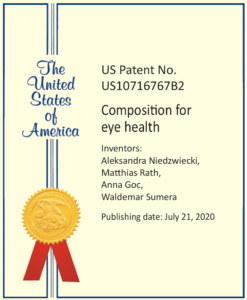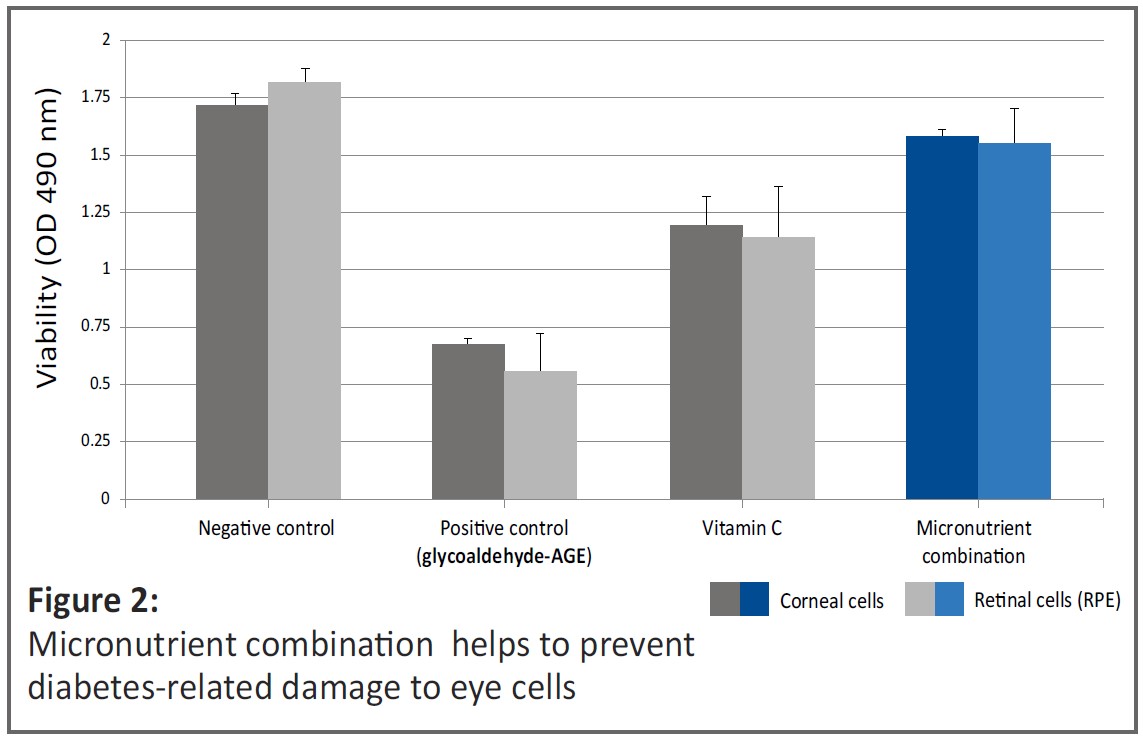The world’s first patented health technology to support normal eye function – naturally
Eye problems can appear at all stages of life, with children and older people being particularly affected. Worldwide more than two billion people have vision problems, with more than half of these being preventable. Eye diseases, such as cataracts, glaucoma, diabetic retinopathy, age-related macular degeneration and others are associated with the ultimate risk of blindness.
Conventional medicine is confined to treating the symptoms of eye disease with pharmaceutical drugs, many of them causing side effects. Betablockers, used for glaucoma treatment, may slow the heart rate, and cause asthma attacks and disorientation. Side effects of other pharmaceutical eye drugs include allergic reactions and inflammation.
Our modern understanding of the cellular root of eye diseases recognizes the primary cause of vision problems as a long-term deficiency of essential micronutrients in the eye cells. Compared with other organs, the eye is particularly susceptible to oxidative damage, owing to its exposure to light and high metabolism. Therefore, dietary antioxidants and natural compounds that help to prevent oxidative damage and inflammation are important in protecting the biological structure and function of our eyes. Particularly important are vitamins C, A, E, carotenoids lutein, zeaxanthin and βcarotene, the trace element zinc, as well as polyphenols.
Micronutrient combination patented to help prevent oxidation–related eye damage
Our institute evaluated the efficacy of vitamin C alone and in combination with certain other micronutrients for their efficacy to protect eye cells against oxidative damage.
The comprehensive research results form the basis of this patent. They show:
Vitamin C
Vitamin A
Vitamin E
Zinc
Grape seed extract
L-Arginine
Blueberry extract
L-Cysteine
Alpha lipoic acid
Lycopene
Lutein
Pine bark extract
Saffron extract
Zeaxanthin
Mixed carotenoids
Figure 1 (from the patent): Micronutrient combination helps to prevent oxidative damage to eye cells. The first column (‘negative control’) shows the survival of cells that are unchallenged by oxidative stress. The second column (‘positive control’) shows the significantly reduced survival rate of eye cells when they are exposed to the damaging oxidative agent hydrogen peroxide (H2O2). Exposure of corneal and retinal epithelial cells to oxidative stress decreased the viability of these cells by over 60% (‘positive control’). This means that under the exposure to such oxidative stress, fewer than 40% of eye cells were able to survive. However, the survival of both corneal and retinal cells exposed to oxidative stress was significantly increased in the presence of vitamin C (column 3). When these challenged eye cells were protected by a combination of vitamin C and other selected micronutrients (column 4), the protective effect was even higher, and almost all eye cells survived.
Figure 2 (from patent): The tested micronutrient combination helps to prevent diabetes-related damage to eye cells. Another highly damaging process affecting our eyes involves metabolic changes occurring in diabetes. One of the most frequent complications of this condition is diabetic eye disease (retinopathy), and even blindness. Diabetes eventually leads to the formation of advanced glycation end products (AGEs), a sort of ‘sugar crust’ covering proteins, lipids, DNA and other constituents of our body.
Figure 2 presents the effects of vitamin C alone and in combination with selected other micronutrients on protecting retinal and corneal eye cells against damage by AGE proteins, caused by high sugar levels.
Under protection by vitamin C, the survival of both types of cells increased – however, only the combination of micronutrients was able to achieve maximum efficacy with about 90% eye cells surviving in the presence of AGEs.
Claims allowed by Patent Office (excerpt):
A nutrient mixture that … ‘pretreats a retinal pigment epithelium and corneal cell of mammals [including humans] before an oxidation damage occurs.’
Nobel Prize‐winner‐supported research paves the way to preventive health care
The Dr. Rath Research Institute is a world leader in science-based natural health. Three decades ago, Dr. Matthias Rath – together with two-time Nobel Laureate Dr. Linus Pauling (†1994) – was already publishing groundbreaking discoveries on the importance of vitamins in fighting cardiovascular diseases.
Over the ensuing decades, the Institute’s research team, under the leadership of Dr. Aleksandra Niedzwiecki, has extended this lifesaving research to comprise natural prevention of cancer, diabetes, viral and bacterial infections and many other diseases.
The approval of this preventive health research by patent offices around the world provides the scientific basis for effective preventive health strategies globally. Patients, therapists, governments and, above all, millions of people now have effective, safe, natural health approaches available to help to prevent widespread diseases.
The Dr. Rath organization operates under a non-profit roof and all profits are used to promote further independent research and education in natural health.
This page provides health research established in connection with natural disease prevention. For patients, we recommend to see a therapist or trained consultant to determine your individual health needs.

‘Science‐based natural health is the basis Micronutrients and Eye Health of modern, preventive health care. The time to build it is now!’
Dr. Matthias Rath
What this patent means
This specific health technology is
- recognized by a government agency,
- novel and has not existed before,
- unique and not available anywhere else,
- protected and cannot be imitated.

What is the difference from a pharmaceutical drug patent?
| Pharmaceutical investment business | Natural health community | |
| Target markets | Disease management | Disease prevention |
| Purpose of patents | Legal tools to secure return on investment (ROI) |
Scientific acknowledgement |
| Consequences for your health |
Cementing continuation of diseases as global markets |
Disease prevention and potential elimination |
| Consequences for national economies |
Exploding health care costs |
Less diseases = lower health care costs |
Supporting Studies
Review of evidence for the usage of antioxidants against eye aging
Carotenoids to improve eye health
Lutein, Zeaxanthin and meso-zeaxanthin supplementation associated with improved eye health
The effect of lutein on eye health
The effects of lutein and zeaxanthin on aspects of eye health
The role of lutein and zeaxanthin in visual and cognitive function throughout life
Nutritional strategies to prevent lens cataract
Lutein supplementation for eye diseases
Dietary sources of lutein and zeaxanthin carotenoids and their role in eye health



